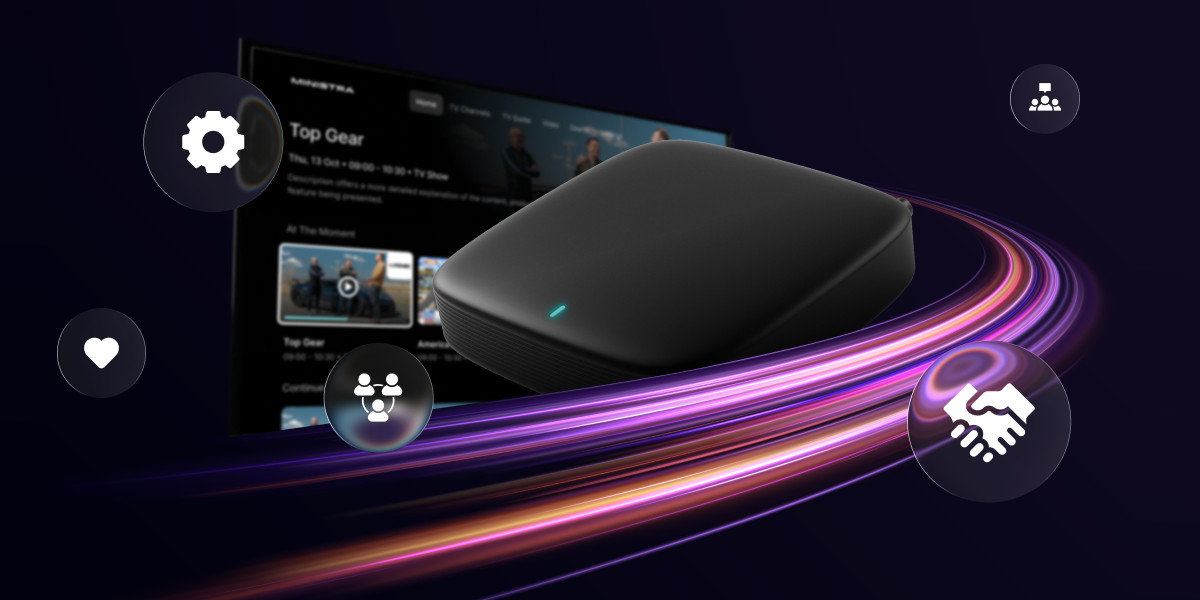Product request
You are looking for a solution:
Select an option, and we will develop the best offer
for you
How Distributors Can Use White-Label IPTV Set-Top Boxes in Partner Programs

The IPTV and OTT market is developing rapidly, opening new growth opportunities for distributors. One of the key trends in recent years has been the use of IPTV white-label solutions. Now firmly established within the industry, white-label products allow distributors and operators to reach a new level of customer engagement.
White-label set-top boxes give brands the ability to stay in the spotlight by creating their own customized IPTV platforms, even if the core product development is handled by a third party.
For distributors, this means expanding their offerings without significant R&D investment. They are now able to provide partners with a ready-made device featuring the customer’s logo and corporate style, along with pre-installed applications. Using private label IPTV hardware enhances end-user trust in the operator or brand and helps build long-term relationships.
Why White-Label is Relevant for IPTV Partner Programs
IPTV business development involving partner programs are based on the concept of mutual growth and benefit. Distributors working with operators and integrators can provide them with a product that fully reflects their brand identity, and white-label set-top boxes perfectly fit into this strategy, allowing operators to strengthen customer loyalty by offering not just a standard device but a product under their own brand.
Moreover, this format lowers market entry barriers. Operators don't need to invest in production or logistics—they receive a turnkey solution from the distributor, who handles everything from hardware procurement to customization. This accelerates the launch process and helps partners achieve profitability faster.
How to Organize the Customization Process
To successfully launch a white-label project and custom-branded IPTV devices, it’s essential to structure the customization process correctly. This typically includes several stages: logo placement, development of a branded interface, and application installation. The more flexible the customization options, the higher the value proposition for the end client.
Distributors play a key role here by providing technical support and quality control. It’s important to offer partners different levels of customization—from basic (logo and packaging) to advanced (UI/UX interface, pre-installed services, integration with billing). This allows you to cover different market segments: from small operators to major players with their own ecosystems.
Customization by Infomir: Creating Solutions Under Your Brand
Infomir offers a full range of IPTV/OTT set-top box customization services. We help partners create unique products that reflect their brand identity and meet market demands. Our customization options include logo placement, branded packaging design, interface customization, as well as pre-installation of applications and services.
Our solutions are flexible and scalable: you can choose basic customization or a comprehensive approach with software refinement and integration into the operator’s ecosystem. This allows partners to strengthen brand recognition, retain customers, and significantly reduce time-to-market.
Benefits for Distributors
For distributors, using white-label solutions opens several strategic advantages. First, IPTV hardware branding is an opportunity to offer a unique product that is difficult to compare by price with mass-market models. When the device carries the operator’s brand, the focus shifts from cost to the value of the service.
Second, this model builds trust and strengthens partnerships. The distributor becomes not just a hardware supplier but a full-fledged technology partner capable of providing an end-to-end solution. This reduces the risk of partner churn and creates a foundation for long-term cooperation.
Financial Benefits and Scalability
From an economic perspective, IPTV and OTT white-label devices and projects enable distributors to increase profitability. Unlike selling standard models, branded IPTV equipment and customized devices are priced higher thanks to unique features and the branding itself. Furthermore, partner programs built on white-label solutions are highly scalable. Once the processes and customization templates are established, distributors can serve more clients without significant cost increases.
IPTV hardware partnerships also open up opportunities for additional services: maintenance, software updates, and new app integrations. It’s not a one-time deal but an ecosystem of IPTV sales channels, where every update or feature package generates revenue.
White-label streaming devices and set-top boxes in partner programs are not just a way to boost sales—they’re a strategic growth tool. Distributors who adopt this strategy gain a competitive advantage and strengthen their market position in IPTV/OTT. It's also a chance to become a key player in the value creation chain.
For operators, white-label middleware is an opportunity to increase brand recognition and retain customers. As part of an effective IPTV distribution strategy, now is the perfect time to leverage the potential of white-label solutions and value-added IPTV services—not only to meet partner demands but to set new standards for cooperation in the digital TV market.
Recommended

IPTV and E-commerce: Prospects of Built-in Online Stores on the TV Screen
Over the past few years, IPTV platforms have gone beyond being merely a channel for delivering television content.

How to Properly Organize Backup Servers for IPTV Streams
The IPTV and OTT market is growing rapidly, with the quality of broadcasts continuing to improve, the number of channels increasing, and the functionality of set-top boxes and applications expanding.

The Evolution of Codecs: From H.264 to AV1 and VVC — What Should Operators Choose?
Over the past decade, the video market has undergone a rapid shift from linear TV to flexible IPTV/OTT services, where image quality and delivery efficiency play a crucial role.










